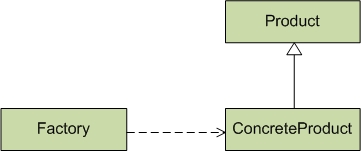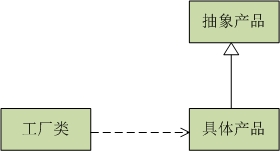 Java
Java
 javaTutorial
javaTutorial
 Taking Java code as an example to explain the simple factory pattern in design patterns
Taking Java code as an example to explain the simple factory pattern in design patterns
Taking Java code as an example to explain the simple factory pattern in design patterns
Simply put, the factory pattern is to return a type of object according to the requirements. The meaning of using the factory pattern is that if the instantiation of the object and the code dependency are too large, it will be inconvenient to expand and maintain. The purpose of using the factory is Decouple the instantiation of the object from the main program code. Let’s take a closer look:
1. Introduction to the Simple Factory Pattern
Simple Factory Pattern (Simple Factory), also known as the "static factory method pattern ". It belongs to the "creation pattern" (the pattern of creating objects) and is a special implementation of the "factory method" pattern.
Usually, we use the simple factory pattern to create classes. For example, obtaining a thread pool object is achieved through the simple factory pattern. Its structure diagram is as follows:

Factory: The factory is the core of the simple factory pattern and provides an external interface. If the client or other program wants to obtain the Product object, it must obtain it through the Factory interface.
Abstract products: Abstract products are abstractions of (many) different products. Product can be an interface or abstract class.
Concrete product: The product object returned in the factory is actually created through ConcreteProduct.
2. Simple factory pattern code model
public class Factory {
public static Product newInstance() {
return new ConcreteProduct();
}
}
public abstract Product {
}
public class ConcreteProduct extends Product {
public ConcreteProduct() {}
}
3. Practical application of simple factory pattern
We are writing a Servlet to process customers When making requests from the client, one Servlet often handles multiple business logics, such as:
protected void doPost(HttpServletRequest request, HttpServletResponse response) {
String flag = request.getParameter("flag");
if(flag.equals("service1")) {
service1();
}else if(flag.equals("service2")) {
service2();
}
...
}The above is the conventional method for our Servlet to handle multiple business logics, writing an if else statement. A better way is to separate the distribution of requests from the Servlet and let the Servlet only handle business logic. We regard various requested Servlets as product classes, javax.servlet.HttpServlet is the product parent class, and javax.servlet.Servlet is the product interface. In this way, we define a ServletFactory, parse the url request in the filter and hand it over to the ServletFactory for processing. That's it. This is a typical simple factory application.
@WebFilter("/TransRequest")
public class TransRequest implements Filter{
private String servletName;
@Override
public void doFilter(ServletRequest request, ServletResponse response,
FilterChain chain) throws IOException, ServletException {
HttpServletRequest myRequest = (HttpServletRequest)request;
//拿到请求的servlet名字, 这里我们约定请求都是/servletName形式
String names[] = myRequest.getRequestURI().trim().split("/");
servletName = names[2];
if( servletName != null) {
//以下是最典型的两句简单工厂的例子
Servlet servlet = ServletFactory.createServlet(servletName);
servlet.service(request, response);
}else
chain.doFilter(request, response);
}Every time a request comes, we use the factory to produce a servlet. This can be more convenient without configuring a large amount of servlet path information in xml. And this will also make the logic clearer. The servlet only handles business at the business layer.
The factory class is as follows:
public class ServletFactory {
public static Servlet createServlet(String servletName) throws ServletException {
if(servletName.equals("servletName1")) {
return new Service1();
}else if(servletName.equals("servletName2")){
return new Service2();
}else{
throw new ServletException("No such servlet");
}
}
}Although the above factory class does not abandon the cumbersome if else, it still solves some problems by using the idea of a simple factory. Simple factory is a very simple design pattern that is not considered a design pattern, and the problems it solves are also very limited. The above request distribution has been implemented in all major javaEE frameworks, such as Struts2. Of course, the framework is not a simple factory.
4. Summary
The simple factory pattern, in summary, is a factory class, a product interface (in fact, it can also be an abstract class, or even an ordinary parent class) and a group of products that implement The specific product of the interface, and this factory class, creates a specific implementation class based on the parameters passed in, and transforms it up to the interface as a result and returns it.
The above is using Java code as an example to explain the content of the simple factory pattern in the design pattern. For more related content, please pay attention to the PHP Chinese website (www.php.cn)!

Hot AI Tools

Undresser.AI Undress
AI-powered app for creating realistic nude photos

AI Clothes Remover
Online AI tool for removing clothes from photos.

Undress AI Tool
Undress images for free

Clothoff.io
AI clothes remover

Video Face Swap
Swap faces in any video effortlessly with our completely free AI face swap tool!

Hot Article

Hot Tools

Notepad++7.3.1
Easy-to-use and free code editor

SublimeText3 Chinese version
Chinese version, very easy to use

Zend Studio 13.0.1
Powerful PHP integrated development environment

Dreamweaver CS6
Visual web development tools

SublimeText3 Mac version
God-level code editing software (SublimeText3)

Hot Topics
 1655
1655
 14
14
 1414
1414
 52
52
 1307
1307
 25
25
 1253
1253
 29
29
 1227
1227
 24
24
 Break or return from Java 8 stream forEach?
Feb 07, 2025 pm 12:09 PM
Break or return from Java 8 stream forEach?
Feb 07, 2025 pm 12:09 PM
Java 8 introduces the Stream API, providing a powerful and expressive way to process data collections. However, a common question when using Stream is: How to break or return from a forEach operation? Traditional loops allow for early interruption or return, but Stream's forEach method does not directly support this method. This article will explain the reasons and explore alternative methods for implementing premature termination in Stream processing systems. Further reading: Java Stream API improvements Understand Stream forEach The forEach method is a terminal operation that performs one operation on each element in the Stream. Its design intention is
 PHP: A Key Language for Web Development
Apr 13, 2025 am 12:08 AM
PHP: A Key Language for Web Development
Apr 13, 2025 am 12:08 AM
PHP is a scripting language widely used on the server side, especially suitable for web development. 1.PHP can embed HTML, process HTTP requests and responses, and supports a variety of databases. 2.PHP is used to generate dynamic web content, process form data, access databases, etc., with strong community support and open source resources. 3. PHP is an interpreted language, and the execution process includes lexical analysis, grammatical analysis, compilation and execution. 4.PHP can be combined with MySQL for advanced applications such as user registration systems. 5. When debugging PHP, you can use functions such as error_reporting() and var_dump(). 6. Optimize PHP code to use caching mechanisms, optimize database queries and use built-in functions. 7
 PHP vs. Python: Understanding the Differences
Apr 11, 2025 am 12:15 AM
PHP vs. Python: Understanding the Differences
Apr 11, 2025 am 12:15 AM
PHP and Python each have their own advantages, and the choice should be based on project requirements. 1.PHP is suitable for web development, with simple syntax and high execution efficiency. 2. Python is suitable for data science and machine learning, with concise syntax and rich libraries.
 PHP vs. Other Languages: A Comparison
Apr 13, 2025 am 12:19 AM
PHP vs. Other Languages: A Comparison
Apr 13, 2025 am 12:19 AM
PHP is suitable for web development, especially in rapid development and processing dynamic content, but is not good at data science and enterprise-level applications. Compared with Python, PHP has more advantages in web development, but is not as good as Python in the field of data science; compared with Java, PHP performs worse in enterprise-level applications, but is more flexible in web development; compared with JavaScript, PHP is more concise in back-end development, but is not as good as JavaScript in front-end development.
 PHP vs. Python: Core Features and Functionality
Apr 13, 2025 am 12:16 AM
PHP vs. Python: Core Features and Functionality
Apr 13, 2025 am 12:16 AM
PHP and Python each have their own advantages and are suitable for different scenarios. 1.PHP is suitable for web development and provides built-in web servers and rich function libraries. 2. Python is suitable for data science and machine learning, with concise syntax and a powerful standard library. When choosing, it should be decided based on project requirements.
 Java Program to Find the Volume of Capsule
Feb 07, 2025 am 11:37 AM
Java Program to Find the Volume of Capsule
Feb 07, 2025 am 11:37 AM
Capsules are three-dimensional geometric figures, composed of a cylinder and a hemisphere at both ends. The volume of the capsule can be calculated by adding the volume of the cylinder and the volume of the hemisphere at both ends. This tutorial will discuss how to calculate the volume of a given capsule in Java using different methods. Capsule volume formula The formula for capsule volume is as follows: Capsule volume = Cylindrical volume Volume Two hemisphere volume in, r: The radius of the hemisphere. h: The height of the cylinder (excluding the hemisphere). Example 1 enter Radius = 5 units Height = 10 units Output Volume = 1570.8 cubic units explain Calculate volume using formula: Volume = π × r2 × h (4
 PHP's Impact: Web Development and Beyond
Apr 18, 2025 am 12:10 AM
PHP's Impact: Web Development and Beyond
Apr 18, 2025 am 12:10 AM
PHPhassignificantlyimpactedwebdevelopmentandextendsbeyondit.1)ItpowersmajorplatformslikeWordPressandexcelsindatabaseinteractions.2)PHP'sadaptabilityallowsittoscaleforlargeapplicationsusingframeworkslikeLaravel.3)Beyondweb,PHPisusedincommand-linescrip
 PHP: The Foundation of Many Websites
Apr 13, 2025 am 12:07 AM
PHP: The Foundation of Many Websites
Apr 13, 2025 am 12:07 AM
The reasons why PHP is the preferred technology stack for many websites include its ease of use, strong community support, and widespread use. 1) Easy to learn and use, suitable for beginners. 2) Have a huge developer community and rich resources. 3) Widely used in WordPress, Drupal and other platforms. 4) Integrate tightly with web servers to simplify development deployment.



